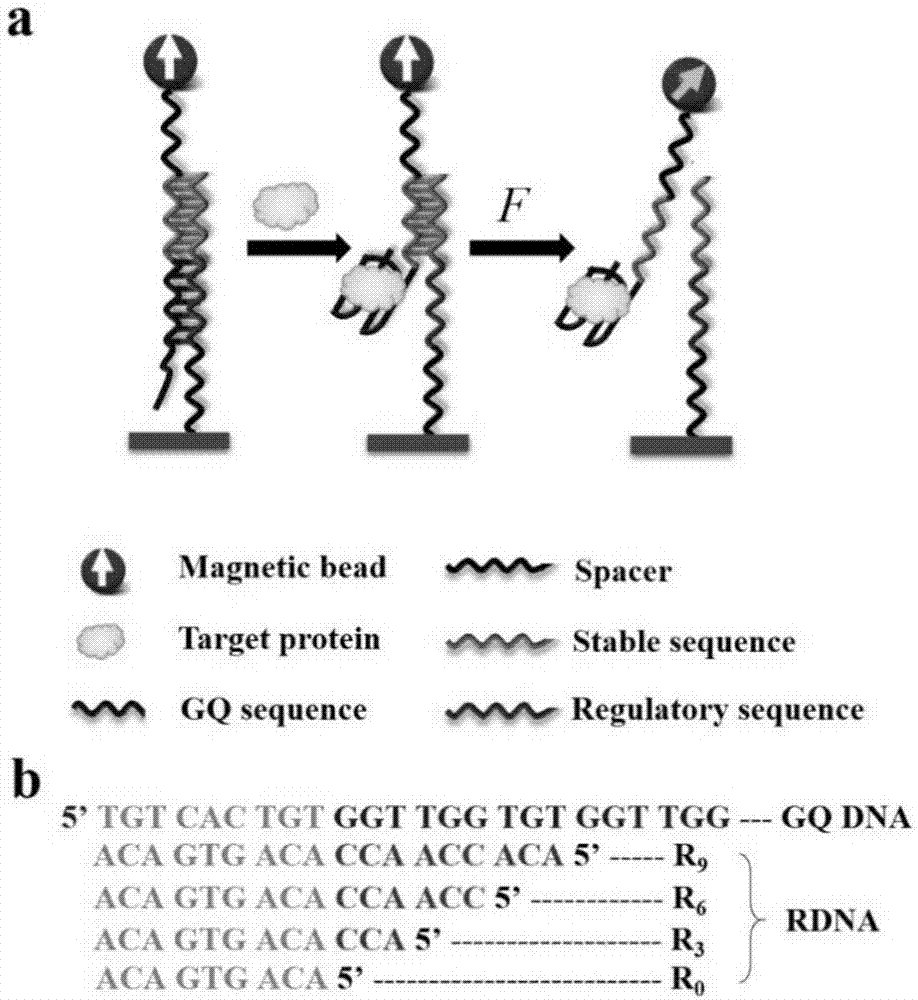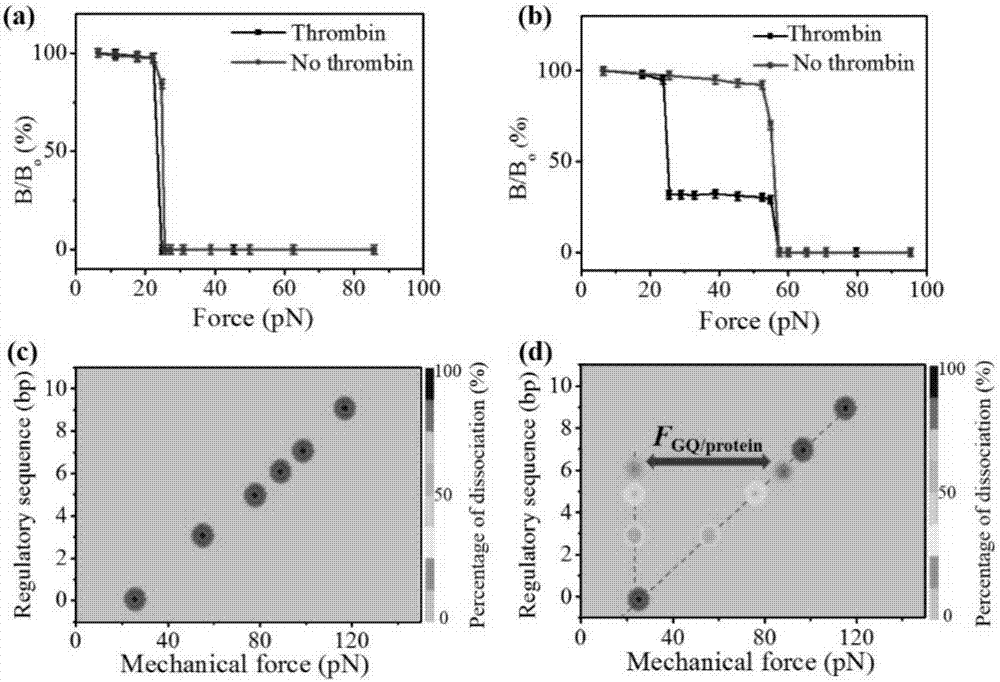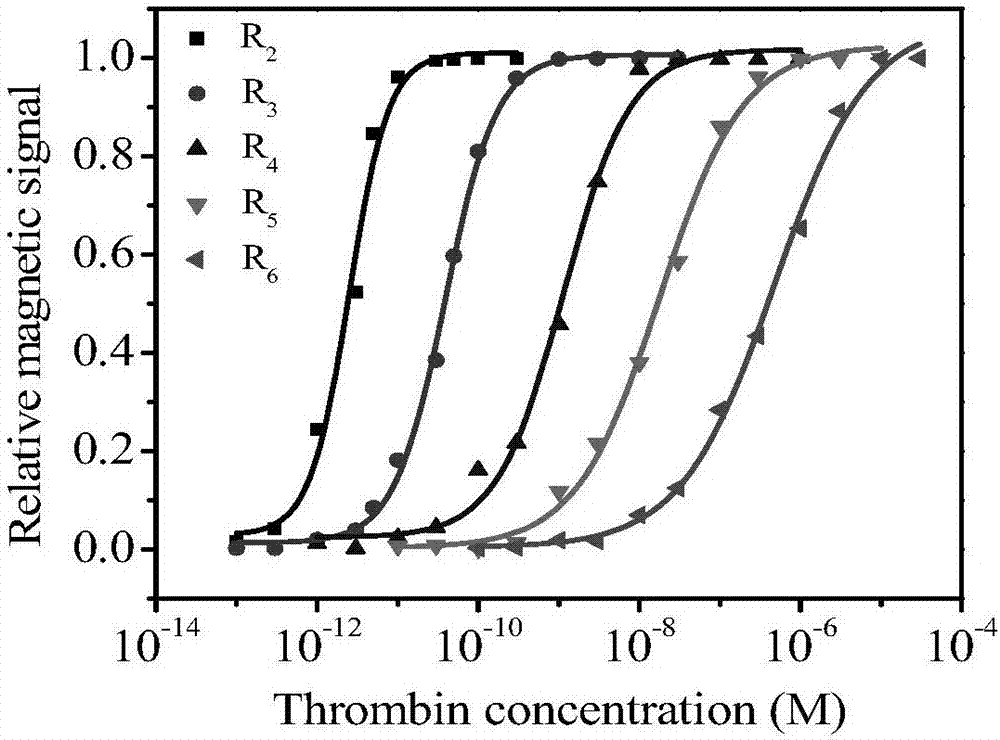Method for detecting thrombin protein concentration
A technology of thrombin and protein, which is applied in the fields of biomedicine and protein detection, can solve the problems of inability to control the range of detection objects, difficulty in meeting detection requirements, and limitation of practical applications, etc., to achieve the expansion of dynamic detection range, wide application range, detection sensitive effect
- Summary
- Abstract
- Description
- Claims
- Application Information
AI Technical Summary
Problems solved by technology
Method used
Image
Examples
Embodiment 1
[0046] Embodiment 1, the preparation of aldehyde glass substrate
[0047] Put the small glass slide in acetone solution for ultrasonic cleaning, then wash it with ultrapure water, and then use 1M NaOH solution for 10 minutes to remove the oil on the surface, then wash it with deionized water and absolute ethanol, and extinguish it at 250°C. Bacteria treatment for 3h. Put the above-mentioned processed small slides into newly prepared piranha solution (piranha solution, volume ratio, 98% concentrated H 2 SO 4 / 30%H 2 o 2 =7:3) treated at 90°C for 30 minutes to hydroxylate the glass surface. The hydroxylated slides were then placed in a toluene solution containing 1% APTES and incubated at room temperature for 2 hours to aminate the surface of the slides. The aminated glass slide was incubated in Tris-HCl buffer containing glutaraldehyde (1% v / v) for 3 hours at room temperature, and then washed twice with Tris-HCl buffer to obtain a modified glass substrate.
Embodiment 2
[0048] Hybridization and immobilization of embodiment 2, DNA
[0049] Mix 50uL 3uM thrombin nucleic acid aptamer (GQ DNA) with 50uL 3uM complementary DNA sequence R i (i=1, 2, 3...15) were mixed in equal volumes, reacted at 90° C. for 5 minutes, and naturally cooled to room temperature to obtain hybridized double-stranded DNA. 20 uL of the hybridized double-stranded DNA solution was drip-coated on the surface of the glass substrate modified in Example 1 of the present invention, and incubated at 4° C. for 10 h. Then use Tris-HCl buffer solution to wash away unbonded double-stranded DNA molecules on the surface, and then incubate with a reference buffer solution containing BSA with a mass volume fraction of 1% for 30 minutes, and then connect to magnetic beads M-280. The process is as follows: figure 1 shown.
Embodiment 3
[0050] Embodiment 3, the measurement of force spectrum
[0051] Add 20uL of 300nM thrombin protein to the above-mentioned glass substrate connected with DNA, and the buffer solution used for dissolving thrombin protein is Tris-HCl buffer (20mM Tris-HCl, 140mM NaCl, 5mM KCl, 1mM CaCl 2 ,1mMMgCl 2 , pH=7.4), under the condition of 37°C, incubate the thrombin protein with the double-stranded DNA for 30min, and wash away the unreacted thrombin protein with standard buffer solution. The above treated sample to be tested was magnetized under a magnet (~0.8T) for 2 minutes, and then centrifuged at 1000 rpm for 5 minutes to remove physical adsorption. The magnetic signal is then detected on an ultra-low field atomic magnetometer. Gradually increase the magnitude of the centrifugal force, and the centrifugation time is still 5 minutes each time, and record the magnetic signal intensity corresponding to each centrifugal force. Due to the non-covalent bond between the double-stranded ...
PUM
| Property | Measurement | Unit |
|---|---|---|
| strength | aaaaa | aaaaa |
Abstract
Description
Claims
Application Information
 Login to View More
Login to View More - R&D
- Intellectual Property
- Life Sciences
- Materials
- Tech Scout
- Unparalleled Data Quality
- Higher Quality Content
- 60% Fewer Hallucinations
Browse by: Latest US Patents, China's latest patents, Technical Efficacy Thesaurus, Application Domain, Technology Topic, Popular Technical Reports.
© 2025 PatSnap. All rights reserved.Legal|Privacy policy|Modern Slavery Act Transparency Statement|Sitemap|About US| Contact US: help@patsnap.com



